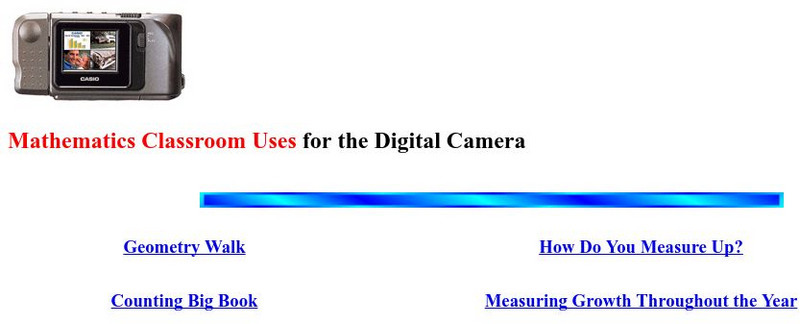Curated OER
One, Two, Three...and They're Off
Students make origami frogs to race. After the race they measure the distance raced, collect the data, enter it into a chart. They then find the mean, median, and mode of the data. Next, students enter this data into Excel at which time...
Curated OER
Transformations, Tessellations, and Technology
Students complete a unit about transformations and tessellations. They explore various tessellation websites, determine which shapes tessellate, complete a log about which website activities they complete, and create a tessellation...
Curated OER
Exploring Area and Perimeter
Two students are blindfolded and each receives a cardboard square, one with pompoms glued around the edge and one with pompoms glued all over the surface. They identify what they feel. The class discusses perimeter and area of polygons....
Curated OER
Geometric Transformations
Students solve problems involving transformations of geometric figures. They review graphing points in the coordinate plain, plot points and connect to create a triangle. Then, they reflect triangles over the x and y axis and use...
Curated OER
All About Ratios
Learners investigate the use of multiplication and division of whole numbers to solve problems including equivalent ratios and rates.
Alabama Learning Exchange
It's Around There Somewhere! Perimeter, and Circumference
Explore the concept of building equations for perimeter and circumference. Learners use rulers to measure the perimeter of half a sheet of paper. Then fold the sheet of paper numerous times, each time measuring perimeter. ...
Curated OER
Reliable Problem Solving Techniques
Students practice the Request-Response-Result problem solving technique. They explore how and when it should be used.
Curated OER
Ratios (Cost of a Habit)
Students consider an individual habit and its cost. They study ratios and proportions, and use that knowledge to calculate the cost of a habit over extended periods of time. write a detailed comparison of the costs.
Curated OER
TE Activity: A Roundabout Way to Mars
Learners investigate Hohmann orbit transfers using cardboard and string while focusing on the orbits of Earth and Mars. They look at the planets orbits around the sun and transfer orbit form one planet to another to determine what a...
Curated OER
Polygons and Plane Figures
Pupils choose a polygon to define and describe, and use Power Point and the Internet to present their polygon.
Curated OER
Snowflake Curve
Students develop an appreciation for complex structures in nature. They observe patterns in nature in relationship to the Real World. Students use observation skills to assist in problem solving. They show comprehension of the concepts...
Curated OER
Lines and Angles
Sixth graders explore lines and angles. They create visual representations of lines, rays and angles by drawing them on paper and using a geoboard. On paper, 6th graders write a summary of the characteristics of their representations.
Curated OER
Two-Dimensional Drawings from Three-Dimensional Objects
Sixth graders identify and draw two-dimensional representations of a three-dimensional object. Students investigate the views of an object and determine that three views are required (front, one side and the top). Students use these...
Curated OER
The Box with the Greatest Volume
Students use measurement tools to measure the nearest 16th of an inch. They connect fractions and their decimal equivalents and compare this with other decimals. Finally, the class uses algebraic concepts and formulas to solve problems.
Curated OER
Eye From the Sky
Learners are introduced to the concept of aerial perspective and scale. Students will use satellite technology to view their neighborhoods and sketch the area surrounding their schools. They will take part in a neighborhood walk to view...
Curated OER
Precision Tools
Learners discuss the appropriateness of using a specific tool to measure and define an object. After measuring the area of their classroom and the objects in it with the appropriate tools, they create a floor plan that makes the most...
Curated OER
Fun Ideas for Getting A-Round in Math CIRCLES
Students see circles in real life and have fun with them
Curated OER
Follow The Falling Meteorite
Students investigate the supposed traveling path of a meteorite. They use sound in order to triangulate the path. The results of the experiment are written on a map to display the path of the meteorite. The culminating activity is when...
University of Regina (Canada)
University of Regina: Math Central: m.c.escher: Mathematics and Visual Arts
This cross-curricular middle school unit integrates mathematics and visual art. Through the study of the M.C. Escher?s work, learners explore tiling from both a mathematical and artistic point of view. Points for discussion and...
Other
University of Central Florida: Mathematics Classroom Uses for the Digital Camera
This site has a few creative lesson plans on using the digital camera in a mathematics classroom. Includes geometry and measurement activities. (The link for the counting book does not work in archived version of site.)
Alabama Learning Exchange
Alex: Build a City on Geometry
The students will be split into small, cooperative groups and build a city following specific guidelines. The students will learn how a city is constructed with angles, intersections, parallel, intersecting, and transversal streets. They...
University of Regina (Canada)
University of Regina: Math Central: Introduction to Slope for Middle Years Mathematics
This collection of five middle school math lessons covers the topic of plane geometry, specifically the concept of slope. The first lesson plan introduces students to plotting points on a Cartesian grid using a Geoboard. Lesson two moves...
National Council of Teachers of Mathematics
The Math Forum: The Cylinder Problem: Middle School Lesson
This lesson offers an interesting, hands-on experience for middle school students studying cylinders. Students will create cylinders, and measure and compare their volumes.
PBS
Pbs Mathline: Bubble Mania Lesson Plan [Pdf]
Determine the area, diameter, and circumerfence of a bubble residue by creating a soap solution and blowing bubbles.























![Pbs Mathline: Bubble Mania Lesson Plan [Pdf] Lesson Plan Pbs Mathline: Bubble Mania Lesson Plan [Pdf] Lesson Plan](https://static.lp.lexp.cloud/images/attachment_defaults/resource/large/FPO-knovation.png)